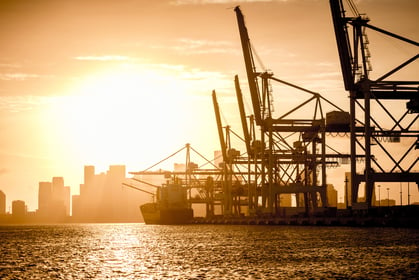What is Multi-Dimensional Monitoring?
Nicole Wanichko - February 11, 2021

With the ever-growing developments of artificial intelligence and real-time analytics, system monitoring is becoming more advanced. While previously, companies could only monitor data with flat metrics, more and more organizations are now making the transition to multi-dimensional monitoring, as a key component of assessing efficacy and resilience in their supply chain. We’re going to discuss why companies are making this switch and what that means for their monitoring operations.
Before getting into multi-dimensional marketing, it's essential to understand how it differs from flat metrics. Flat metrics perform surface-level analysis but do not segment technology into various roles and components. These systems are unable to consider the relationships between different layers of analytical metrics. Without the context of these complex relationships, organizations have to manually differentiate these and figure out how these relationships may impact alerts, performance problems, and outages to avoid the false positives that flat metrics frequently deliver.
Multi-dimensional monitoring differs from flat metrics in that it can understand the relationships between layers of metrics while considering different time perspectives and analysis goals. MDM can visualize the supply situation and provide a transparent look at any potential bottlenecks, ranges of coverage, and inventory. The right Supply Chain Management (SCM) software with this function combines the standardization, relational visibility, and super monitoring that move beyond monitoring and become observability in real time. This is vital to saving your organization time and money. By obtaining access to multiple dimensions of concerns, whether failures in services or reaching near capacity, you can identify problems and manage deviations before they become critical.
Multi-Dimensional Monitoring in Supply Chains
Now that we have defined the significant differences between multi-dimensional monitoring and flat metrics let's go into more detail about what multi-dimensional monitoring does and how it works. In terms of the supply chain, this monitoring method is key in optimizing efficiency and tracking operations from start to finish. It is vital to have full visibility (a.k.a turbo transparency) through every step of your supply chain, allowing customers to understand what's happening during this process. This visibility includes real-time tracking of all aspects of your supply chain, with constant updates alerting you of the status and progress of cargo shipments, regulations, and operational risks. There are major benefits to having this visibility, including allowing clients to develop cost-saving strategies in real-time, optimize their supply chain, assess performance, and detect bottlenecks. Overall, this intelligence will enable you to improve strategic decision making and daily operations and guarantee deliverability.
Shipping
One of the most significant advantages of multi-dimensional monitoring in the supply chain is the ability to monitor your cargo with IoT enabled real-time monitoring and tracking. For any organization, it is vital to be aware of your products' status and location at all times. With multi-dimensional monitoring, you will have automated locating and sensing technology on all containers and cargo. This automation will allow you to collect data and receive notification of any supply chain blind spots you may not have been aware of prior. Not only will this provide you consistent location updates in real-time, but you will also be mindful of the condition of your cargo from the point of manufacture to the point of delivery. With this knowledge, you will avoid any surprises of damaged or missing cargo and allow you to plan for problems before they arise. This gives you a secure basis for decision-making with a controlling, rather than reactive, role.
The solution's monitoring data can get as granular as you need. You can be informed of any temperature and humidity fluctuations, alerting you if temperature surpasses a pre-defined threshold to ensure the quality of your cargo stays intact. Additional services include door opening and light intrusion notifications, and shock detection, once again making you aware of any possible risks to the quality and condition of your products. These alerts will help you identify risks and avoid shipping disruptions before becoming detrimental to your supply chain. If critical alerts arise, a responsive team will assist your team in providing comprehensive options to configure notifications and aid you in preventing and stopping interferences. With so much monitoring of your cargo, it will be as if it’s still in your hands.
Optimization
Through this IoT real-time monitoring, you will be able to optimize supply chain optimizations by planning ahead of disruptions and spotting risks. With real-time inventory updates, you will improve inventory management and reduce inventory levels, reducing the need to overstock. Additionally, in revealing cargo mishandling hotspots, you can see where areas for improvement lie and prioritize cargo inspections in those areas. Finally, optimize working-capital by replacing manual routines and individual spreadsheets with automated solutions allowing you to delegate manual work on other critical metrics and KPIs.
In terms of financial optimization, you will decrease logistics costs and develop other cost-saving strategies by increasing efficiency and accuracy in logistics. With a more accurate calculation of risks, financers will effectively optimize their organization's flow of finances and reduce costs. Many multi-dimensional monitoring services also provide audit compliant balance sheet optimization, supporting both traditional and non-traditional supply chain financing services. Additionally, 24/7 access to your cargo will improve your organization's cash flow by improving your liquidity management. Once you align your supply chain metrics with your overall business strategy, you will be able to drive performance.
Regulatory Compliance
In addition to monitoring shipping and optimizing operations, multi-dimensional monitoring providers align with all regulatory compliance requirements. As the supply chain industry updates, so do their compliance regulations. Dimensional technology is continuously incorporating new regulatory and Green Shipping requirements such as compliance with the EU MRV (Monitoring, Reporting, and Verification) as another implementation of efficiency and success. This dynamic technology can also manage future regulations to ensure that your operations are monitored and correctly reported. As regulatory compliance is mandatory for shipping and merchant vessels, you must prioritize this to avoid significant future disruptions.
Multi-dimensional monitoring is a revolutionary system in managing your supply chain through advanced tracking technologies, allowing you to optimize your supply chain while obeying regulations and improving operations. Transform how you monitor your cargo with real-time updates so that you can enhance shipping and communication. With this innovative monitoring system, your organization will have exceptionally accurate visibility of your cargo and complete control of your supply chain every step of the way so that you can deliver timely and quality products to your clients.
If you want to learn more get your Guide to Multi Dimension Monitoring
In this Guide you will learn:
- The Advantages of Multi Dimension Monitoring
- Perspectives from a production or a transport point of view
- Potentials for Planners and Dispatchers
LATEST POSTS
- Understand Circular Economy in The Manufacturing Industry
- How Can Industry 4.0 IT Integration Be Achieved Smoothly?
- The Significance of Order Sequencing in Discrete Manufacturing
- How to improve your Supply Chain Management: The Power of Control Towers
- Optimizing Human Resource Scheduling in Manufacturing: A Technological Approach



